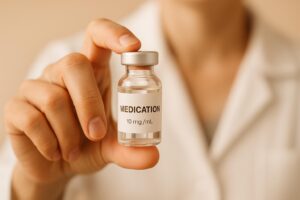5 Signs GLP-1 Medication Is Working for You

GLP-1 medications, such as Semaglutide and Tirzepatide, are transforming how people manage weight and blood sugar. These treatments help regulate appetite, support steady weight loss, and improve metabolic health. If you’re taking a GLP-1 medication, here are five clear signs it’s working:
- Reduced Appetite: You feel fuller for longer, eat smaller portions naturally, and experience fewer cravings.
- Consistent Weight Loss: Expect gradual progress, typically 1–2 pounds per week, with improved energy and easier daily activities.
- Better Blood Sugar Levels: Steady energy throughout the day and improved HbA1C results after a few months.
- More Energy and Improved Mood: Increased focus, better sleep, and a more positive outlook.
- Improved Health Metrics: Lower blood pressure, cholesterol, and other measurable health improvements.
These changes often occur within weeks to months, helping you build healthier habits over time. Regular check-ins with your healthcare provider can ensure your treatment stays on track.
GLP-1 medications and weight loss: How fast is too fast? | Ohio State Medical Center

1. Your Appetite Has Decreased
A noticeable drop in appetite is a clear sign that your GLP-1 medication is doing its job. These medications work by slowing down how quickly your stomach empties, which helps you feel full for longer periods.
What You Might Notice
You may find that your portion sizes naturally shrink without you having to force it. Those cravings for high-calorie, sugary, or carb-heavy foods? They might not feel as strong anymore, making it easier to stick to a more balanced diet. Plus, with hunger no longer dominating your day, you might feel more relaxed about when you eat, giving you the flexibility to adjust your meal schedule as needed.
Benefits for Your Metabolism
Eating less often leads to better blood sugar control, especially when you’re cutting back on refined carbs and sugary snacks. Smaller portions also mean your digestive system doesn’t have to work as hard, which can help improve your overall metabolic health. Over time, these small changes can make a big difference.
Building Healthy Habits That Last
These shifts in appetite and eating patterns often happen within weeks of starting the medication. Many people find that this sets the stage for long-term, healthier eating habits – without the need for extreme dieting or restrictions.
2. You’re Losing Weight Consistently
A steady drop in weight is a clear indicator that your GLP-1 medication is doing its job. These medications are designed to encourage gradual and manageable weight loss over time.
Observable Changes
You can expect to lose about 1–2 pounds per week, which might show up as looser-fitting clothes and a boost in energy. Beyond these physical differences, you may notice changes in your daily routine. Tasks that once felt tiring might become easier, and you could find yourself naturally moving more throughout the day. Some people even report better sleep and waking up more refreshed as the pounds come off. These changes are often signs of improving overall health.
Impact on Metabolic Health
Losing weight consistently has a ripple effect on your metabolic health. It can lead to lower blood pressure and cholesterol levels, as shedding extra weight reduces the strain on your heart and blood vessels.
Additionally, your body’s ability to process insulin improves with weight loss. This creates a positive feedback loop: better insulin sensitivity supports ongoing weight loss, and as you continue to lose weight, your metabolic health gets even better. These benefits often work together to keep you on track.
Building Lasting Habits
GLP-1 medications encourage steady progress, steering clear of the cycle of losing and regaining weight. Most people find that they can stick to their new eating patterns without feeling constantly hungry or battling cravings.
What’s more, this approach isn’t just about the numbers on the scale – it’s about creating a healthier relationship with food. The habits you develop while on the medication often stick with you, making it easier to maintain your progress long after you’ve stopped taking it. This steady, habit-focused journey sets the stage for long-term success.
3. Your Blood Sugar Has Improved
Better blood sugar control is a clear sign that your GLP-1 medication is doing its job in managing glucose levels. Originally developed for type 2 diabetes, these medications work by helping stabilize blood sugar levels effectively.
Physical and Behavioral Changes You May Notice
One noticeable benefit is steady energy throughout the day, without the extreme highs and lows caused by blood sugar spikes and crashes. Feeling less sluggish after meals is another positive sign, as these medications promote a gradual release of glucose into your bloodstream, avoiding sharp post-meal increases.
Your daily routine may also feel more manageable. Instead of sudden hunger pangs or moments of weakness between meals, you’ll experience more consistent energy. This stability not only improves your day-to-day life but also lays the groundwork for better blood sugar management in the long run. These effects tend to become more pronounced after about 8 weeks of use.
How It Affects Your Metabolic Health
To monitor your progress, your healthcare provider will likely perform regular HbA1C tests. These medications work by triggering insulin release and reducing glucagon production, which slows the release of glucose from your stomach and prevents your liver from adding extra glucose to your bloodstream.
The hemoglobin A1C (HbA1C) test, done after at least 8 weeks of treatment, measures your average blood sugar levels over the past 2 to 3 months. This gives you and your doctor a clear idea of how well the medication is working. If your A1C levels aren’t where they need to be, your provider might adjust your dosage to improve control.
Long-Term Benefits and Progress
Unlike some diabetes treatments that can lead to weight gain, GLP-1 medications like Ozempic (semaglutide), Mounjaro (tirzepatide), and Victoza (liraglutide) support both blood sugar control and weight loss. This creates a positive feedback loop: losing weight improves your body’s insulin sensitivity, which further helps maintain stable blood sugar levels.
The goal is to achieve lower and more stable blood sugar levels, particularly after meals. If you’re using these medications alongside insulin or sulfonylureas, it’s important to watch for hypoglycemia (blood sugar levels below 70 mg/dL). Keeping your blood sugar steady not only boosts your energy but also complements improvements in appetite and weight management, reinforcing the progress you’re making.
sbb-itb-e2779c3
4. You Have More Energy and Better Mood
Many users report feeling more energetic and experiencing a noticeable lift in their mood while on GLP-1 medication. These positive changes are often a sign that the treatment is working effectively.
Observable Changes
You might find yourself with steadier energy levels, sharper mental clarity, and better focus throughout the day. These immediate benefits can serve as a strong foundation for making lasting lifestyle adjustments.
Long-Term Benefits You May Notice
Over time, these improvements can lead to greater ease in handling daily tasks and a more active lifestyle. With increased energy, you may feel more confident and less weighed down by stress, including concerns about food choices. This boost often translates into better social interactions, improved performance at work, and an overall sense of well-being.
In short, consistent energy, sharper focus, and an uplifted mood are all encouraging signs that your GLP-1 treatment is helping you feel your best.
5. Your Health Numbers Are Better
One clear way to determine if your GLP-1 medication is working is by monitoring key health metrics during your routine check-ups. Lab results and physical evaluations provide measurable evidence of progress. These numbers complement the visible and physical changes you may notice, like reduced appetite, weight loss, and increased energy. Together, they paint a more complete picture of how your treatment is going.
Positive Changes in Metabolic Health
Bloodwork often highlights promising improvements. For instance, many patients see their A1C levels move closer to healthier ranges after several months of treatment. Cholesterol levels may also shift, showing a better balance between LDL and HDL. Additionally, blood pressure readings can trend lower over time, which might even allow your doctor to adjust or reduce other medications.
Physical and Lifestyle Improvements
The changes in your lab results often align with physical and lifestyle improvements you can feel. A shrinking waistline, for instance, can signal a decrease in visceral fat – a win for your metabolic health. You might also notice better sleep quality or less joint stiffness, both signs that your body is responding well to the treatment.
Gradual, Long-Term Benefits
GLP-1 medications are designed to promote steady progress across various health markers. With regular follow-ups, your doctor can track these improvements and fine-tune your treatment plan to align with your health goals.
Make sure to share any changes you observe with your healthcare provider. Open communication helps ensure your treatment stays on the right path for your unique needs.
Expected Results by Medication Type
When it comes to GLP-1 medications, the weight loss outcomes can vary significantly depending on the specific medication. Understanding these differences can help set realistic expectations and guide your treatment decisions.
Liraglutide typically results in about 5% net weight loss. For someone weighing 200 lbs, this translates to roughly 10 lbs. While the weight loss may be less dramatic compared to other GLP-1 options, liraglutide still offers benefits like appetite control and potential health improvements.
Semaglutide delivers stronger results, with clinical studies showing around 12% net weight loss. For a 200-lb individual, that’s an additional 24 lbs. Many patients report noticeable appetite suppression, which can make it easier to stick to dietary changes over time.
Tirzepatide has shown the most impressive outcomes, with studies indicating a net weight loss of 18%–20% at higher doses. For a 200-lb person, this could mean losing 36–40 lbs. Its dual-action mechanism contributes to its effectiveness, making it a standout option for substantial weight loss.
| Medication | Expected Weight Loss | Example (200-lb person) | Key Features |
|---|---|---|---|
| Liraglutide | ~5% (net) | ~10 lbs | Daily injection, moderate appetite control |
| Semaglutide | ~12% (net) | ~24 lbs | Weekly injection, strong appetite suppression |
| Tirzepatide | ~18–20% (net) | ~36–40 lbs | Weekly injection, dual-action effect |
For weight loss purposes, these medications are prescribed at higher doses than those used for managing diabetes. Your healthcare provider will carefully adjust your dosage over time to balance effectiveness with minimizing side effects.
Clinical trials suggest that semaglutide or tirzepatide can lead to a total body weight reduction of 10%–15% over several months. However, individual results depend on factors like your starting weight, how well you stick to lifestyle changes, and how your body responds to the medication. These insights can help shape a treatment plan tailored to your specific health goals.
Conclusion
The points outlined above serve as a helpful guide to evaluate how well your GLP-1 medication is working. Keep an eye on these key indicators – reduced appetite, steady weight loss, better blood sugar control, higher energy levels, and improved health metrics – to measure your progress effectively.
Make it a habit to monitor your weight, energy levels, and lab results. This information can play a crucial role in shaping your treatment plan.
Stay in close contact with your healthcare provider to discuss your progress. They can help with adjusting your dosage or addressing any side effects you might experience.
For the best results, combine your GLP-1 medication with healthy lifestyle habits. Celebrate your achievements, remain patient with the process, and maintain open communication with your healthcare team along the way.
FAQs
How soon can you notice changes in appetite and weight with GLP-1 medications?
Most people begin to see shifts in their appetite and weight within just a few weeks of starting GLP-1 medications. Common changes include feeling less hungry, eating smaller portions, and gradually shedding some pounds.
That said, results can differ from person to person. Factors like your dosage, daily habits, and overall health all play a role. Sticking to your healthcare provider’s advice is key to making sure the medication works as intended for you.
What lifestyle or dietary changes can help maximize the benefits of GLP-1 medications?
To maximize the benefits of GLP-1 medications, pairing them with healthy lifestyle choices can make a big difference. Start by focusing on balanced meals that include protein, fiber, and healthy fats – these not only support weight loss but also promote overall well-being. Don’t forget to stay hydrated and keep an eye on portion sizes to help manage hunger more effectively.
Adding regular physical activity into your routine, like walking or strength training, can also boost your progress. If you’re unsure where to start or want a tailored plan, working with a registered dietitian can help you meet your nutritional needs while staying on track with your goals.
What should I do if I have side effects or don’t see the expected results from my GLP-1 medication?
If you’re dealing with side effects like nausea, vomiting, constipation, or diarrhea, reach out to your healthcare provider right away. They can offer guidance to help manage these symptoms and, if needed, adjust your treatment plan to better suit your needs.
On the other hand, if you’re not seeing progress in areas like weight loss, blood sugar levels, or your overall well-being, it’s a good idea to schedule a follow-up with your doctor. They can evaluate your progress, review your medication dosage, and make any adjustments to keep you moving toward your health goals.
Related Blog Posts

Transforming Lives, One Step at a Time
Keep reading
Ultimate Guide to Semaglutide Dose Customization
This guide explores semaglutide dosing for diabetes and weight loss, emphasizing personalized adjustments for optimal results.
6 Common Drug Interactions with GLP-1 Medications
Learn about six common drug interactions with GLP-1 medications and how to manage potential risks for safe treatment.
Mounjaro Insurance Coverage: What to Know
Learn how insurance coverage for Mounjaro varies based on diabetes treatment and weight loss, along with tips for approval and cost-saving options.
Semaglutide vs. Tirzepatide: Max Dose
Explore the differences between two weight loss medications, their maximum doses, effectiveness, and safety profiles for better health outcomes.
GLP-1 Diet Plan: 7-Day Meal Guide
Learn how to effectively pair GLP-1 medications with nutritious meal planning for weight loss, improved digestion, and stable blood sugar.
Nausea and GLP-1 Medications: Solutions That Work
Learn effective strategies to manage nausea from GLP-1 medications, including dietary tips and the importance of personalized dosing.
Plateau Problems: Restarting Weight Loss
Stalled weight loss on GLP-1 medications is common but manageable. Explore strategies to break through plateaus and regain momentum.
Body Fat Percentage Estimator – Know Your Stats
Estimate your body fat percentage in seconds with our free tool. Just input your height, weight, and more for instant results. Try it now!
Wegovy vs Ozempic: Complete Comparison
Explore the differences between two popular medications for weight management and diabetes, including dosing, side effects, and effectiveness.









